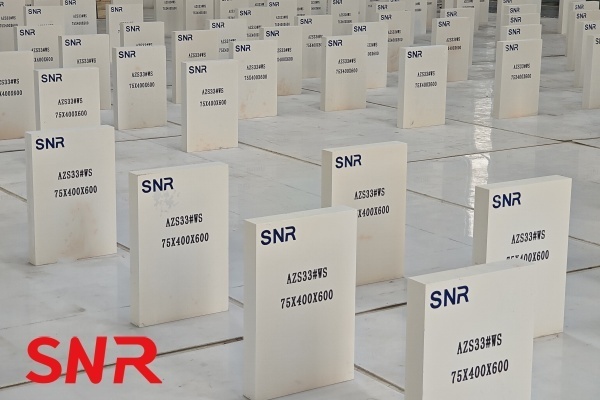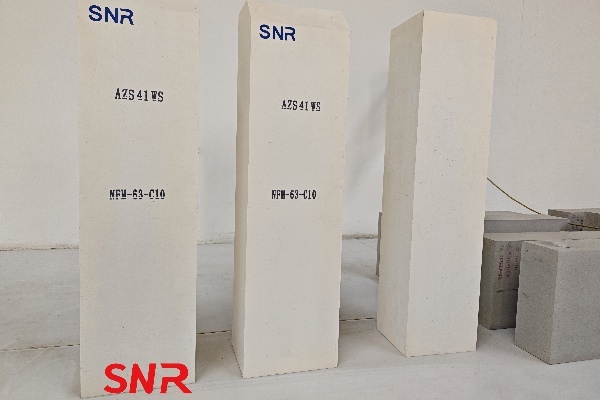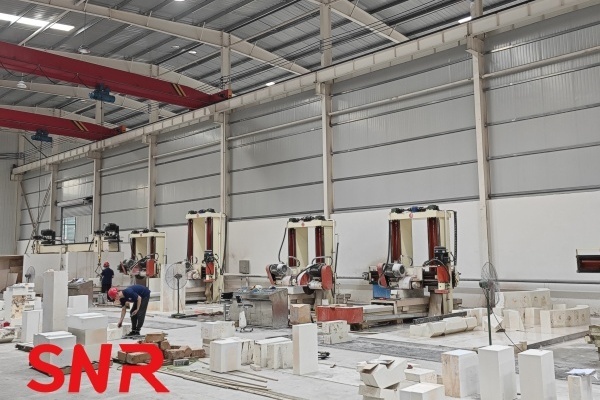
Glass melting furnace is a thermal equipment for melting glass composed of refractory materials.The efficiency and lifespan of a glass melting furnace largely depend on the type and quality of refractory materials. The development of glass production technology depends to a large extent on the improvement of refractory material manufacturing technology. Therefore, the reasonable selection and use of refractory materials is a very important content in the design of glass melting furnace. As a high-quality refractory material, fused cast alumina blocks are widely used in key parts of float glass furnaces. Its excellent performance ensures the efficiency and stability of glass production. This article aims to deeply discuss the application of fused cast alumina blocks in float glass furnaces, elaborating from the aspects of material characteristics, application of key parts, application effects, and precautions.
Fused cast alumina blocks are made by melting alumina in an electric arc furnace and casting it into a model of a specified specific shape. After annealing and heat preservation, the required product is obtained through processing. The general production process is to use high-purity calcined alumina (over 95%) and a small amount of additives. After the ingredients are mixed, they are put into an electric arc furnace, smelted at a high temperature of more than 2300°C, cast into a prefabricated mold, and then insulated. After annealing, the blanks are taken out and become finished products that meet the requirements after precise cold processing, pre-assembly and inspection.

Fused cast alumina blocks are divided into three kinds according to the different crystal forms and quantities of alumina: the first kind is α-Al2O3 as the main crystalline phase, which is called α-corundum blocks; The second kind is mainly α-Al2O3 and β-Al2O3 crystal phase, the content is roughly equivalent, called αβ corundum block; The third kind is mainly β-al2o3 crystalline phase, called β corundum block. The second and third kinds of fused corundum blocks commonly used in float glass furnace are fused αβcorundum blocks and β corundum blocks. In this paper, the physicochemical properties of αβ fused corundum brick and β-fused corundum brick and their application in float glass furnace are introduced.
1.2 Performance analysis of fused cast alumina block
►Fused αβ corundum block
Fused αβ corundum block is composed of about 50% α-Al2O3 and β-Al2O3, the two crystals interleaved to form a very dense structure, with excellent alkali erosion. The corrosion resistance at high temperature (above 1350 ℃) is slightly worse than that of fused AZS blocks, but at lower than 1350 ℃, its resistance to fused glass erosion is comparable to that of fused AZS blocks. Because it does not contain impurities such as Fe2O3 and TiO2, the matrix glass phase is very small, and there are fewer foreign bodies such as bubbles when in contact with the molten glass, so as to not pollute the matrix glass. Fused αβ corundum block has dense crystal and excellent corrosion resistance to glass liquid below 1350 ℃, so it is widely used in glass melting furnace working pool and later parts.

.png)
Excellent corrosion resistance: extremely resistant to molten glass and corrosive media in the furnace.
Thermal shock stability: ability to maintain structural stability despite drastic changes in temperature.
Low pollution: minimal pollution to the glass liquid, maintaining the purity of the glass.
High strength and low thermal conductivity: maintain high strength at high temperatures while reducing heat conduction losses.
2.Structure and working process of float glass furnace
The float glass furnace is mainly composed of doghouse, regenerator , port and working end. The raw material is uniformly input from the doghouse on both sides of the melting pool, and the flame alternately emits from the port to form a horseshoe shaped flame, which improves the thermal efficiency and reduces the energy consumption. In such a high temperature environment, the high temperature resistance and corrosion resistance of fused cast alumina block are particularly important.

.png)
3.Application parts of fused cast alumina blocks in float glass furnace
Fused cast alumina blocks, play an extremely important role in float glass furnaces. These bricks are widely used because of their excellent high temperature stability, erosion resistance, thermal shock resistance and mechanical strength. The following are typical application areas of fused corundum blocks in float glass furnaces:
Melting Department
Side wall: Fused zirconium corundum blocks are often used to build the side wall of the melting part. They are in direct contact with high-temperature glass liquid and resist the erosion of slag and glass liquid.
Breast wall: In the melting section, the breast wall is a key part connecting the tank wall and the kiln roof, where fused cast alumina blocks can provide necessary heat resistance and corrosion resistance protection.
Port arch: The top structure of a port needs to be able to withstand high temperatures and thermal shock, and fused cast alumina blocks are an ideal choice.
Cooling Department
Cooling side wall: The side wall of the cooling part also requires refractory materials to resist high temperature and erosion. Fused zirconium corundum blocks are widely used because of their excellent performance.
Launder: In the cooling section, the launder is used to guide the flow of molten glass, and the fused cast alumina blocks can effectively prevent the erosion and contamination of the molten glass.
Work Department
Furnace roof: Although silica blocks are mostly used on the furnace roof, in certain areas such as the furnace roof above the port, fused cast alumina blocks are also selected for their thermal shock resistance.
Port stack: The port stack is a structure for preheating air, where the fused cast alumina blocks can withstand high temperatures and periodic thermal shocks.
Throat:
Weir: The weir is a key part to control the flow rate of the glass liquid. Fused zirconium corundum blocks (such as AZS-41#) are used here because of their extremely high corrosion resistance and low pollution.
Bubble bricks: used to introduce gas and promote the homogenization of glass liquid. Fused cast alumina blocks can effectively prevent gas erosion and structural damage.
Doghouse
Corner of the doghouse: Fused cast alumina blocks can be used at the corners of the doghouse port to resist mechanical impact and high temperature erosion when materials are put in.
Other key parts
Flame outlet: Fused cast alumina blocks can be used to protect the flame outlet from direct impact of flame and high temperature.
Knife-shaped side wall bricks: These specially shaped bricks can be used in specific areas of the furnace to provide additional structural stability and corrosion resistance.
When selecting fused cast alumina blocks, site-specific working conditions, including temperature, chemical aggressiveness, mechanical stress and thermal shock, should be considered to ensure the selected material provides optimal protection. In addition, the installation and maintenance of bricks are also important factors in ensuring efficient operation of the furnace. The correct selection and installation of fused cast alumina bricks can significantly extend the service life of the furnace, reduce the frequency of maintenance, and improve production efficiency.
4.Analysis of application effects of fused cast alumina blocks
Erosion resistance
The high-purity alpha-alumina and beta-alumina crystal structures of fused cast alumina blocks give them excellent corrosion resistance. This means that the bricks can effectively resist the erosion of molten glass and other aggressive media in the furnace. This feature ensures that the furnace lining is structurally stable, reducing maintenance and downtime due to erosion, thereby increasing the overall efficiency of the production line.
Thermal shock stability
Due to the high material purity of fused cast alumina blocks, there is minimal pollution to the molten glass, which helps maintain the purity and optical properties of the glass. This is crucial for the production of high-quality glass products, as it directly affects the transparency and appearance quality of the final product.
High temperature resistance
Fused cast alumina blocks can withstand high temperatures up to over 1800°C, making them suitable for use in the hottest parts of the furnace, such as the melting pool, runners and working end. This high-temperature resistance ensures that the furnace can continue to operate at its best without production interruptions due to material failure.
Strength and wear resistance
The high hardness and strength of fused cast alumina blocks make them not easily damaged when subjected to mechanical stress, especially under the flow of materials inside the furnace and the erosion of molten glass, while still maintaining structural stability. This wear resistance helps reduce brick wear and extend the operating cycle of the furnace.
Energy saving effect
The low thermal conductivity of fused cast alumina blocks helps reduce heat losses in the furnace, which means energy consumption can be saved while maintaining the same operating temperature. This energy-saving effect has direct economic benefits for reducing production costs and improving energy efficiency.
Economic benefits
Although the initial investment cost of fused cast alumina blocks is relatively high, considering that they can significantly extend the service life of the furnace, reduce the number of downtimes for maintenance, and improve production efficiency and product
quality, in the long term, they bring higher investment Economic benefits and cost savings.

.png)
5.Precautions for use
Temperature control: During the heating and cooling process, the temperature change speed needs to be strictly controlled to avoid excessive temperature fluctuations in the range of 950-1150°C to avoid cracks.
Atmosphere control: Fused cast alumina blocks manufactured under reducing atmosphere have poor corrosion resistance, so attention needs to be paid to atmosphere control when using them.
Cooling air volume: Since fused cast alumina blocks have good thermal conductivity, when used as side wall bricks, it is necessary to increase the cooling air volume near the liquid surface to ensure sufficient cooling.
Fused cast alumina blocks play an indispensable role in float glass furnaces because of their excellent performance. They not only improve the operating efficiency of the melting furnace and the quality of glass products, but also extend the service life of it.
.jpg)
.png)
Henan SNR Refractory Co., Ltd that specializes in the production of fused cast AZS blocks. You can never go wrong choosing us. We use high-quality raw materials and advanced electric fusion technology to ensure that each brick has extremely high purity and density. We understand that each client's needs are unique. Therefore, we offer customization services to meet your individual needs, whether it is size, shape or specific chemical composition requirements. From the procurement of raw materials to the delivery of finished products, every step has undergone strict quality inspection to ensure that every indicator meets or exceeds industry standards, so you can use it with confidence.
If you have any needs , you can contact me at any time.
E-mail:moon@snrefractory.com 
Web:www.snrefractory.com